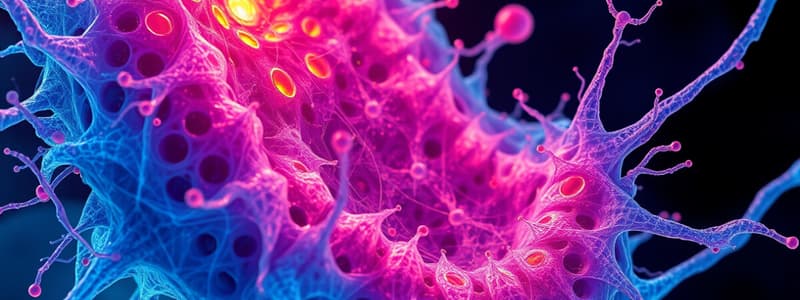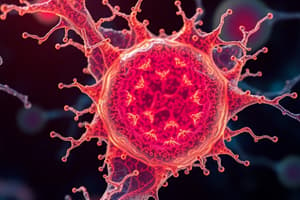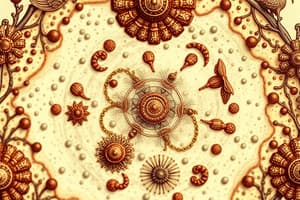Podcast
Questions and Answers
What did Robert Hooke observe when he used his crude compound microscope on cork?
What did Robert Hooke observe when he used his crude compound microscope on cork?
- Honeycomb-like structures (correct)
- Living bacteria
- Organelles within cells
- Nuclei of cells
Which statement correctly reflects the basic tenets of cell theory prior to the addition of the fourth tenet?
Which statement correctly reflects the basic tenets of cell theory prior to the addition of the fourth tenet?
- All cells contain the same genetic information.
- All living things are composed of cells. (correct)
- Cells arise spontaneously from non-living matter.
- Cells produce energy through photosynthesis.
What did Anton van Leeuwenhoek contribute to the study of cells?
What did Anton van Leeuwenhoek contribute to the study of cells?
- He discovered the structure of DNA.
- He formulated the basic principles of cell theory.
- He invented the first optical microscope.
- He was the first to view living cells under a microscope. (correct)
Which of the following statements about Hooke's law is true?
Which of the following statements about Hooke's law is true?
What advancement was made to the original cell theory?
What advancement was made to the original cell theory?
Which researcher demonstrated that diseased cells can arise from normal cells?
Which researcher demonstrated that diseased cells can arise from normal cells?
Which statement is correct regarding the relationship between tissues and cells?
Which statement is correct regarding the relationship between tissues and cells?
How did earlier scientists perceive organisms prior to the 1600s?
How did earlier scientists perceive organisms prior to the 1600s?
Flashcards are hidden until you start studying
Study Notes
Historical Perspectives on Cell Discovery
- Before the 1600s, organisms were viewed as complete entities without separable parts due to limited microscopic technology.
- In 1665, Robert Hooke utilized a crude compound microscope to examine cork, discovering honeycomb-like structures he termed "cells," which were actually nonliving, desiccated cells.
- Anton van Leeuwenhoek first observed living cells in 1674, marking a significant milestone in cellular biology.
- Subsequent research established that tissues are composed of distinct cells, leading to the understanding that tissue function is dependent on cellular function.
Key Contributions and Cell Theory
- In 1850, Rudolph Virchow concluded that diseased cells emerge from normal cells within healthy tissues.
- Robert Hooke is also known for Hooke’s Law, represented by the equation F = –kx, which defines the relationship between elastic force, spring constant, and spring displacement.
- Hooke's Law is related to the broader topic of elastic potential energy, relevant in physics studies.
Cell Theory Development
- The original cell theory comprises three key tenets:
- All living organisms are made of cells.
- The cell is the fundamental functional unit of life.
- Cells can only arise from preexisting cells.
- A fourth tenet introduced later posits that:
- Cells carry genetic information as DNA, which is inherited from parent to daughter cells.
Viruses and Cell Theory Dilemma
- Viruses challenge traditional cell theory as they contain genetic material yet cannot reproduce independently, violating the third and fourth tenets.
- Viruses can replicate only by invading host cells and may utilize RNA as their genetic information.
- Due to these characteristics, viruses do not qualify as living organisms.
Studying That Suits You
Use AI to generate personalized quizzes and flashcards to suit your learning preferences.




